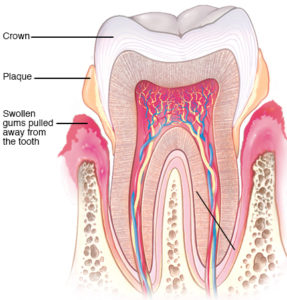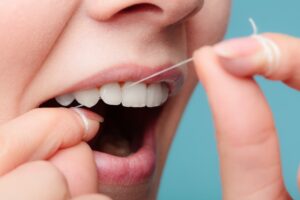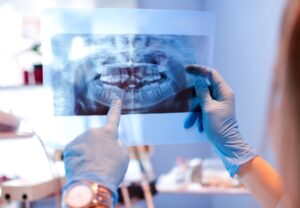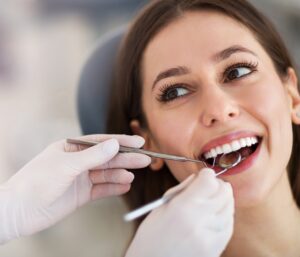Header logo
header top contact widget
Systemic Inflammation
How To Avoid Gum Disease & Cavities From Sugar This Holiday
Posted on Nov 12, 2020 by William J. Claiborne, DDS MS
Regardless of size and distancing limitations on 2020 holiday gatherings, you can bet that Americans will still consume the yummy indulgences associated with the season. After all, we all need comfort food these days. The holidays simply give us “justification” for eating the sugary, rich treats we’ve waited all year to enjoy. We release the guilt and know we’ll pay for it through our new year’s resolutions.
I’m the last person on earth who would preach abstinence when it comes to things like thick egg nog, sugar cookies and pecan pie. Like you, I wait all year to savor things like this. However, I’m also a periodontist and have a unique look at what this added sugar can do to teeth and gums.
Keep in mind that all food (as well as beverages other than plain water) cause an acidic surge into the mouth. This is sent in via saliva and is the first stage of the digestive process. This acid is so strong it can actually soften tooth enamel for 20-30 minutes, leaving you with a higher risk for tooth decay.
Sugar also super-charges oral bacteria, which are living, eating and breeding organisms. They thrive in colonies as they subsist on gum tissues. As bacteria levels grow, the gums become inflamed. This is the first stage of periodontal (gum) disease.
As gum disease worsens, the inflammation caused by these bacteria can lead to persistent bad breath, receded gums that expose sensitive tooth roots, and gums that darken in color. If untreated, pus pockets can eventually form at the base of some teeth and attack the tooth supporting structures beneath the gums.
Eventually, teeth will loosen and can require removal. Also known as periodontal disease, this is the nation’s leading cause of adult tooth loss.
Even without the holidays, Americans are the biggest sugar consumers on earth. Although the World Health Organization (WHO) recommends no more than 5% of daily sugar intake, or less than 25 grams, Americans consume 82 grams each day, on average. That translates into over 19 teaspoons of sugar per day and 66 pounds each year, per person.
When researchers from the University College London & London School of Hygiene studied public health records from around the world, they found that 92% of American adults have cavities. Compare this to Nigeria, a country with a diet very low in sugar, where only 2% of the population have had tooth decay. Also concerning were their findings that nearly 90% of America’s school age children have experienced tooth decay.
Childhood obesity is also out of control. The Centers For Disease Control & Prevention (CDC) reports that the U.S. percentage of children with obesity “has more than tripled since the 1970s. Today, about one in five school-aged children (ages 6–19) has obesity.” That’s nearly one-third of children who are overweight or obese. https://www.cdc.gov/healthyschools/obesity/facts.htm Obesity is when fat content of the body is over thirty percent of its overall mass.
According to the Centers For Disease Control & Prevention (CDC), adults in the U.S. who are categorized as obese is at nearly 40 percent. Another 30 percent are categorized at overweight.
While sugar is not the only culprit, Americans have been lured into a lifestyle surrounded by sugary snacks and beverages. (After all, ads tell us that we need to grab a Snickers bar, not an apple, as an afternoon pick-me-up.)
You may be surprised to know that studies show that sugar is even addictive. It activates the same regions in the brain that react to cocaine. (https://www.brainmdhealth.com/blog/what-do-sugar-and-cocaine-have-in-common/)
How does this apply to your smile? Research has shown that obese adults have a 6 times higher potential to develop periodontal (gum) disease. As a periodontal specialist, my goal is always to help patients achieve optimal oral health. In our Asheville periodontal dental office, we address the risks of periodontal disease with our patients without judgement of their weight, but rather how we can help them enjoy a healthier smile.
As difficult as losing weight can be, it is important to be aware of risk factors that can make you more susceptible to gum disease. Initial symptoms include gums that are tender, swollen, and may bleed when brushing. This stage, known as gingivitis, is actually reversible with prompt, thorough oral hygiene.
This holiday, try to reduce your intake of sugar and carbohydrates. This will help to lower your potential for damage by oral bacteria, reducing your risk for cavities and gum disease. Additionally, be committed to a thorough at-home routine of daily flossing, twice a day brushing and drinking plenty of water.
If you are experiencing symptoms of gum disease, however, it is important to be seen by a periodontist as soon as possible to halt further progression. A periodontist is a dental specialist who has advanced training in treating all stages of gum disease as well as in the placement of dental implants. The earlier the treatment, the less involved treatment requirements will be. Gum disease will not improve without professional care.
Call 828-274-9440 to schedule an initial examination or begin with a consultation.
Save Money & Time At The Dentist! Practice Effective Home Care.
Posted on Sep 22, 2020 by William J. Claiborne, DDS MS
If you could prevent a deadly disease by devoting 5 or so minutes a day to a few at-home basics, you’d probably be all in. Of course, we know that ample sleep, daily exercise and a healthy diet is beneficial to our health. What some people don’t know is the intricate connection between oral health and overall health.
Adults are becoming more aware of how the health in their mouths impacts the risk of developing serious, and even deadly, diseases. To begin, periodontal (gum) disease is the nation’s leading cause of adult tooth loss. The challenges associated with dentures and partials can cause a lifetime of frustrations, costs and psychological woes.
As devastating as tooth loss can be to one’s overall health, it is now known that the bacteria of gum disease can become blood borne. Research has shown this infectious bacteria can trigger inflammatory reactions elsewhere in the body, correlating to heart disease, stroke, high blood pressure, some cancers, diabetes, arthritis, impotency, preterm babies and more.
It is wise to have regular dental check-ups without fail. These 6-month visits can remove built-up plaque from teeth, tend to gum inflammation, and catch small problems before they become big ones. However, what you do in-between these visits can have a major impact on your oral health.
Below are some tips to make your oral care at home more effective …
• Your Toothbrush – Plaque is a buildup of oral bacteria that coats teeth and gums. If not removed daily, it forms a hardened mass of calculus (or tartar) attached to teeth. Calculus cannot be brushed or flossed away (and is what your hygienist is scraping off teeth during cleanings).
– An electric toothbrush can help in the prevention of tooth loss. Studies have shown that electric brushing promotes better gum health and slower progression of gum disease. It is also said to reduce tooth loss by 20 percent. Many of the newer models include timers to indicate the time needed for each quadrant of your mouth. This is your teeth divided into 4 sections. Some also warn when using too much pressure.
– If you prefer a manual toothbrush, stay away from stiffer bristles, which can be damaging to tooth enamel. Also, avoid pressing down firmly or using a scrubbing, ‘back & forth’ motion. Hard bristle toothbrushes can also damage tender gum tissues. Use a circular motion over both sides of each tooth and along the tops with gentle pressure. (Hint: if your bristle are flayed out after a couple of months, you’re pressing down too hard.)
– Whether using a manual or electric tooth brush, it is necessary to brush twice a day for effective results. In order to thoroughly remove the sticky film of plaque from teeth, brush at least two minutes each time.
– After each brushing, brush your tongue with your toothbrush. The tongue has grooves and pores where oral bacteria breed and thrive. Brushing the tongue will uproot these organisms and help to significantly reduce the bacteria level in your mouth.
• Your Dental Floss – Another way to improve gum health, lower cavity risk, and prevent tooth loss is through flossing. It is estimated that only 31 percent of American adults floss on a daily basis. Because brushing cannot dislodge all food particles caught between teeth, daily flossing should be a part of oral hygiene routines.
– Proper flossing is easy for those who are in the habit of it and takes less than a minute. However, the key word here is “proper.” Flossing is best done with about 18 inches of floss. We recommend unwaxed but people with tight teeth find waxed helps them avoid having to ‘pop’ in-between teeth, which can cut into tender gum tissues. Wrap both ends of the floss around the forefingers. Use the thumbs and middle fingers to help maneuver the floss.
– Go slowly as you move the floss back and forth to get in-between and scrape down each tooth’s side several times. Move the floss just slightly below the line where teeth meet gum tissues to dislodge bacteria at the base of teeth. Adjust the floss so you have a clean section after flossing every 3-4 teeth. Be sure to scrape the backs of molars (or the farthest back teeth) on top and bottom.
– For those who have problems with manual dexterity or find the maneuver awkward, water flossers are effective alternatives (shown to be just as effective as manual flossing) and easy to use. A water flosser pulsates a stream of water between teeth that is forceful enough to dislodge trapped food bits but without harming teeth or gums. They are affordable, easy to purchase online or in many stores, and easy to use.
• Your Oral Moisture – Having ‘dry mouth,’ the frequent state of oral dryness, can cause bad breath and lead to higher risks of cavities and gum disease. Saliva is your mouth’s natural rinsing agent that helps cleanse oral bacteria from the mouth. This keeps bacteria to a minimum and their ability to cause problems at lower risk.
– When saliva flow is insufficient, however, bacteria ‘hang around’ in the mouth longer and multiply rapidly. Periodic dry mouth can occur from consuming alcoholic beverages, caffeine and is a normal part of the aging process. Certain medications can also cause oral dryness. These include antihistamines and some prescribed for depression and urinary incontinence. Medical conditions, including acid reflux, sinus infections, diabetes and bronchitis can also cause dry mouth. A bad cold, snoring or just being in the habit of breathing through the mouth are drying as well.
– And the worst culprit of all for dry mouth? Smoking.
– Drink lots of water throughout the day. (Sports drinks and colas don’t count.) If you take medications that have drying side effects, use an oral rinse that replenishes saliva. There are several available over-the-counter.
• Your Diet – What you eat and drink can easily undo all the good you’ve done in your oral home care routine that day. And, you may not even know some of these consumables are putting your smile at risk. These include:
Sugar & Carbs: The American population over-indulges in sweets and carbohydrates to an often unhealthy extent. The obesity rate in the U.S. (nearly 40% of adults) makes it pretty clear this isn’t occurring from eating green beans and grilled fish. The problem for your smile is how oral bacteria are super-charged by the foods we should be avoiding or enjoying on a limited basis. Our diets now are boosting the reproductive ability of oral bacteria. And, since many of these foods stick to teeth, the potential for damage is much higher.
Caffeine: Caffeine has a drying effect on oral tissues. A dry mouth means less saliva flow, which gives oral bacteria less opportunity to be rinsed from the mouth efficiently. Caffeinated beverages include coffee, tea, colas, and many energy drinks. While not caffeinated, alcoholic beverages are also drying to oral tissues. Remember, oral bacteria is the source of the majority of problems in the mouth.
Wine (and other alcoholic beverages): While wine is said to be good for you, how it is consumed creates a particular problem when it comes to your smile. Anytime you eat or drink, your mouth experiences an acid attack, which is a normal part of the digestive process. However, this acid is so potent that it can soften tooth enamel, leaving teeth vulnerable to decay for about 30 minutes. As most people do, sipping wine over a period of time simply draws out this acid bath. Add to that the acidity of wine and your smile gets a one-two punch for a higher risk of decay.
Citrus & acidic foods and beverages: The acidity in citrus (oranges, lemons, grapefruit, etc.) can erode tooth enamel, leaving them more susceptible to decay. And, it’s not just tart-tasting fruits that bring this risk. Foods with vinegar (pickles, salad dressings, etc.) and tomatoes or tomato-based foods (red pasta sauce, catsup, etc.) have an acidic effect on tooth enamel that heightens the risk of decay.
Snacking: As mentioned above, every time you eat or drink, an acid attack begins in the mouth. This means that when you sip your soda or nibble on a cookie, an acid attack kicks in. When your mouth is experiencing frequent acid attacks during the day, it’s easy to see why the damage can cause such high risks to tooth enamel and gum tissues.
Be aware of the recommendations above to do a better job at having a clean mouth. If you feel you may be experiencing symptoms of periodontal disease, however, don’t delay. You should be seen at your earliest convenience for treatment since this disease will only worsen over time.
Signs of gum disease include tender gums that bleed easily when brushing, gums that darken in color to red (versus a healthy pink), frequent bad breath, and gums that pull away from teeth (receded gums) and expose darker, root areas of the tooth.
As a periodontist, I specialize in gum tissues (as well as dental implants). Our environment optimizes patient outcomes and comfort throughout treatment. Call (828) 274-9440 to schedule an examination or begin with a consultation appointment.
Smoking, Vaping Lead To Gum Disease, Tooth Loss.
Posted on Sep 15, 2020 by William J. Claiborne, DDS MS
With all good intentions, adults occasionally trade one bad habit for another. For instance, a commitment to exercise more often for weight loss can easily backfire when justifying a thick smoothie as a daily reward.
This is what worries me about Vaping. Vaping, the use of e-cigarettes, hit the market around 2007. It is designed to deliver nicotine through a vapor. Although the vapor is generally not labeled as harmful (it’s not “safe”, either), its nicotine is no less harmful to the user as that delivered via cigarette smoke.
Unfortunately, many cigarette users switched to vaping based on the perception that “e-cigs” were a safer alternative. For those who wanted to wean themselves off of cigarettes through this switch, very few achieve that goal as a result.
A 2018 report by the National Academy of Sciences, Engineering, and Medicine concluded there was “evidence that e-cigarette use increases the frequency and intensity of cigarette smoking in the future.”
Teens have been most susceptible to the hazards of vaping. It is the most commonly used tobacco product among U.S. youth. E-cigarette use among middle and high school students increased 900 percent during 2011-2015. According to the Surgeon General, 1 in 5 high school students and 1 in 20 middle school students were using e-cigarettes in 2018.
Unfortunately, nicotine exposure can harm the brain as it develops, until about age 25. During adolescence, nicotine use can affect learning, memory and attention span as well as increase their risk for future drug addictions. (https://e-cigarettes.surgeongeneral.gov/documents/surgeon-generals-advisory-on-e-cigarette-use-among-youth-2018.pdf)
As a periodontist in Asheville, NC, my concern when it comes to oral health is what many cigarette smokers and vapers don’t realize when it comes to high risks to their smiles.
In our periodontal dental office, I’ve seen how significantly the habit of cigarette smoking can have on one’s smile. It’s no secret that smoking cigarettes can stain teeth and cause bad breath. However, nicotine in any form is a hazardous force in the mouth.
According to the American Dental Association (ADA), smoking can cause the gums to recede from teeth, exposing vulnerable tooth root sections. This enables easier entry of oral bacteria into the structures that support tooth roots. Smoking can also delay healing following periodontal therapy, extractions or implant placement. The longer it takes oral tissues to heal, the greater the risks for infection to develop.
Additionally, smoking increases the risks of oral cancer, lesions inside the mouth, periodontal (gum) disease, enamel erosion and tooth loss. It greatly reduces saliva flow in the mouth, which is a tremendous aid in removing bacteria and food particles from the mouth, helping to control bacteria levels. The condition of “dry mouth” also causes bad breath.
Because of the vape’s moist presence in the mouth, the assumption with vaping over smoking cigarettes is the “benefit” of oral dryness. However, this is easily dispelled when looking at the true facts.
While there are more than 7,000 chemicals found in the smoke of tobacco products, (including nicotine, tar, carbon monoxide, acetaldehyde and N-nitrosamines), nicotine is the primary addicting component. A study of some e-cigarette products found the vapor contains known carcinogens and toxic chemicals, as well as potentially toxic metal particles from the device itself.
The e-liquids delivered by these devices typically contain nicotine, propylene or polyethylene glycol, glycerin, and additives. Sound safe? Not at all.
According to the Centers for Disease Control & Prevention (CDC), a smoker has twice the risk for gum disease compared with that of a nonsmoker. (https://www.cdc.gov/tobacco/campaign/tips/diseases/periodontal-gum-disease.html)
When a patient is diagnosed with advanced periodontal disease (periodontitis), they must make a commitment of time and expense to rid this inflammatory disease from their mouths. For those who ignore its presence or assume it will get better on its own, the disease will simply progress further.
Gum disease begins with sore gums that may bleed while brushing teeth. Or, it may cause no noticeable symptoms at all in early stages.
As it worsens, gum disease will cause frequent bad breath, tender gums that turn red, gum recession, and gums that bleed easily when brushing. Pus pockets may form on the gums. As it attacks the structures beneath the gum line, teeth may loosen or shift.
As the nation’s leading cause of adult tooth loss, it brings the hard decisions (and expense) for replacement. After all, you need teeth for eating and speaking. Do you go with dental implants? Or, do you take on the challenges that come with dentures and partials? As hard as the decisions of replacing teeth can be, gum disease can bring even more devastation with it.
Research has linked the bacteria of gum disease to serious health problems. These include heart disease, stroke, preterm babies, arthritis, diabetes, impotency, some cancers and even Alzheimer’s disease. These connections occur through the infectious bacteria of gum disease entering the bloodstream through tears in diseased gum tissues.
Once in the bloodstream, the bacteria can travel throughout the body and create inflammatory reactions. This “systemic inflammation” is able to trigger the onset of some diseases and conditions or even further the development of others.
Certainly, we all have the right to determine what is in our best interest as far as our own health goes. However, I believe that many individuals end up in our office with serious gum problems and facing tooth loss because of what they did not know. Having factual information allows us to make wise decisions for our health and well-being.
As a periodontist, I have advanced skills in the treatment of all stages of periodontal (gum) disease. My dental specialty also includes the diagnosis and placement of dental implants. Here, our patients can relax under Oral or IV sedation (“twilight sleep”) while having their smiles restored. We also create a customized care program that allows each person to maintain good oral health once their treatment is complete.
 If you smoke or vape, don’t assume “that won’t happen to me.” The reason we wear seat belts in cars is because there are great risks when we do not. The risks for losing your teeth and having potent bacteria running rampant through your system is something you can take easy measures to prevent.
If you smoke or vape, don’t assume “that won’t happen to me.” The reason we wear seat belts in cars is because there are great risks when we do not. The risks for losing your teeth and having potent bacteria running rampant through your system is something you can take easy measures to prevent.
Experiencing symptoms associated with gum disease? We urge you to schedule an examination appointment as soon as possible. Call our beautiful, comfortable Asheville office at 828-274-9440. A referral is not necessary.
Afraid Of The Dentist? Let’s Help You Get Past That For A Healthy Smile!
Posted on Jul 22, 2020 by William J. Claiborne, DDS MS
By some estimates, having a fear of dental visits affects over 70 percent of American adults. When people are afraid of going to the dentist, many often do not receive the regular care necessary to maintain a healthy smile.
As an Asheville Periodontist, I find that the origin of many who develop periodontal (gum) disease is from fear associated with dental visits. It is not unusual for a fearful dental patient to avoid going to the dentist for years, only ‘giving in’ when something becomes so painful they can no longer delay treatment.
We know that when it comes to dental fear, different people have different levels. Some patients are very relaxed in our office from the moment they walk in and throughout treatment. Others are fine until they are seated in the treatment chair. Still, others are anxious throughout their visit.
A study published by the Dental Research Journal revealed nearly 59 percent of 473 adult participants had dental fears. The study included males and females of varying ages and education levels. Although females presented a higher likelihood for dental fear, there was very little difference elsewhere. What did stand out, however, was how many had experienced traumatic dental episodes.
Unfortunately, a traumatic experience in a dental chair with a too-rough dentist tends to remain in the subconscious forever. Many fears are the result of a frightful experience as a child, feeling helpless and afraid. Such an experience tends to make an indelible mark on the subconscious and resurface whenever a dentist or dental office comes to mind.
If you experience these feelings associated with dental visits, there is nothing ‘wrong’ with you. However, delays in care can allow small problems to become more complex, requiring more involved treatment.
Many high-fear patients only force themselves into a dental chair when they are in such pain that they have no choice. It is far easier for adults to find a way to have regular exams and cleanings to prevent emergency needs. This begins by finding the right dental office.
Until then, regular dental check-ups are something that can’t be duplicated at home. Even a thorough, daily brushing and flossing routine misses bacteria on occasion. Within the course of just 48 hours, oral bacteria can form a cement-hard colony attached to tooth surfaces. This accumulation of bacteria eats away at tooth enamel and gum tissues.
As oral bacteria consume gum tissues, inflammation begins. This is gingivitis, the initial stage of gum disease. In this, the gums are tender and occasionally bleed when brushing. As gingivitis progresses to periodontal disease, symptoms include persistent bad breath and gums that turn red versus a healthy pink color. Gum tissues may begin to recede, exposing sensitive areas of tooth roots.
Eventually, the infectious bacteria will attack further beneath the gum line. This inflammation leads to damage to the bone structures that support tooth roots. Pus pockets may form on gums and teeth may loosen. To no surprise, periodontal disease is the nation’s leading cause of adult tooth loss.
This infectious bacteria doesn’t just remain in the mouth. Through tears in weakened gum tissues, it can enter the bloodstream. It’s presence can trigger inflammatory reactions that have been linked to heart disease, stroke, some cancers, preterm babies, arthritis, diabetes, erectile dysfunction (ED), and impotency. Some studies are showing a correlation to Alzheimer’s disease.
What we often find with high-fear patients is their assumption that good at-home care can take the place of their regular care visits. However, even a diligent home-care routine leaves them susceptible to oral bacteria. A number of factors heighten vulnerability to bacterial accumulation, including dry mouth and diet.
Dry mouth occurs due to a wide range of factors. Some medications have a drying affect on the mouth. Certain foods and beverages contribute to dry mouth, especially those containing caffeine and alcohol. Smoking is very drying to oral tissues. And, the aging process leaves us with drier mouths.
Eating sugary foods and many carbohydrates are just as detrimental to oral health. Many Americans snack during the day, often on chips, crackers and candy bars – which are then washed down with sugary sodas. All this converts into a sugar based super-food in the mouth that provides oral bacteria with sustenance that super charges their reproduction.
How does a fearful adult overcome the problem so they can have the dental care they need?
In our office, patient comfort is a priority at every visit. We have even designed our reception area to pamper you from the moment you enter. Patients in this area can enjoy a selection of gourmet coffees, cable television and WIFI connection. The seating is comfortable and our front office staff are attentive to your needs.
We offer a private consultation room for patients as well. In this room, we can discuss treatment and answer questions in a comfortable setting. This allows patients to become better informed about their treatment needs and options versus communicating while they are seated in a treatment chair.
Our surgical suite offers a rather unique setting for a periodontal office. A large window provides beautiful mountain views, very soothing to our patients. In addition, we offer oral sedation as well as I.V. sedation (twilight sleep) for most procedures, if desired.
Oral sedation is a pill that helps patients relax. It also has an amnesiac effect, leaving most with little or no memory of treatment afterward. I.V. sedation places the patient in a deeper sedative state, also erasing memory of the procedure. It is administered by a doctor of anesthesiology for optimal comfort and safety. With both, patients are monitored with advanced safety equipment throughout treatment.
Our patients also find our entire staff is a unified team who reflect sincere compassion and commitment to exceptional, comfortable care. While the doctors involved in your care are all top-notch, I must admit that our staff are the pros at making our patients feel truly pampered.
When patients realize that our goal is to provide exceptional care and comfort, most relax. This creates a sense of trust that causes many to no longer perceive dental care as dreaded, frightening events. Once the obstacle of fear is replaced with feelings of trust, the process to achieve a healthy, confident smile becomes a much easier one.
If you or someone you know has fear that has prevented dental care, the possibility of gum disease is pretty high. We suggest beginning with a consultation appointment, which occurs in our private consultation room. This is removed from the clinical area and provides a relaxed setting where patients can share their unique needs and concerns.
Call 828-274-9440 to schedule or learn more. I’m sure you’ll find our friendly telephone staff is welcoming and reassuring from the very first conversation.
Recent Posts
Categories
Archives
- September 2024
- August 2024
- July 2024
- June 2024
- May 2024
- April 2024
- March 2024
- February 2024
- January 2024
- December 2023
- November 2023
- October 2023
- September 2023
- August 2023
- July 2023
- June 2023
- May 2023
- April 2023
- March 2023
- February 2023
- January 2023
- December 2022
- November 2022
- October 2022
- September 2022
- August 2022
- July 2022
- June 2022
- May 2022
- April 2022
- March 2022
- February 2022
- January 2022
- December 2021
- November 2021
- October 2021
- September 2021
- August 2021
- July 2021
- June 2021
- May 2021
- April 2021
- March 2021
- February 2021
- January 2021
- December 2020
- November 2020
- October 2020
- September 2020
- August 2020
- July 2020
- June 2020
- May 2020
- April 2020
- March 2020
- February 2020
- January 2020
- December 2019
- November 2019
- October 2019
- September 2019
- August 2019
- July 2019
- June 2019
- May 2019
- April 2019
- March 2019
- February 2019
- January 2019
- December 2018
- November 2018
- October 2018
- September 2018
- August 2018
- July 2018
- June 2018
- May 2018
- April 2018
- March 2018
- February 2018
- January 2018
- December 2017
- November 2017
- October 2017
- September 2017
- August 2017
- July 2017
- June 2017
- May 2017
- April 2017
- March 2017
- February 2017
- January 2017
- December 2016
- November 2016
- October 2016
- September 2016
- August 2016
- July 2016
- June 2016
- May 2016
- April 2016
- March 2016
- February 2016
- January 2016
- December 2015
- November 2015
- October 2015
- September 2015
- August 2015
- July 2015
- June 2015
- May 2015
- April 2015
- March 2015
- February 2015
- January 2015
- December 2014
- November 2014
- October 2014
- September 2014
- August 2014
- July 2014
- June 2014
- May 2014
- April 2014
- March 2014
- February 2014
- January 2014
- December 2013
- November 2013
- October 2013
- September 2013
- August 2013
- July 2013
- June 2013
- May 2013
- April 2013
- March 2013
- February 2013
- January 2013
- December 2012
- November 2012
- October 2012
- September 2012
- August 2012
- July 2012
- June 2012


